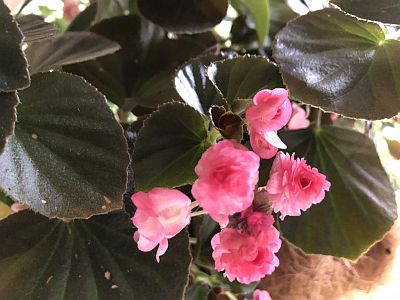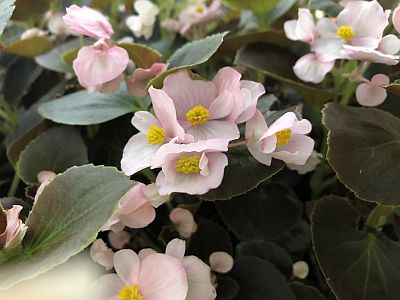Wax-Leaf Begonia
Begonias are native to moist tropical subtropical climates and belong to a genus of more than 1300 different species. Begonia semperfloren-cultorum or Wax-Leaf Begonia is an herbaceous perennial. Herbaceous meaning the fleshy stems are green, not woody but soft. The leaves have a waxy look, thus the name Wax begonia.
Wax Begonias are recognized for their colorful leaves and flowers. Wax begonias look good in containers, especially in large planters and urns and as mass plantings in garden beds. They are compact, mounding plants with an abundance of blooms in summer and Autumn.
Begonias species are divided into several groups, fibrous rooted, rhizomatous and tuberous-rooted begonias. Rhizomatous-rooted begonias, Rex begonias are good for pots or greenhouse plants and are not winter hardy. Tuberous begonias don’t do well in our area.
Wax begonias such as B. Cucullata variety Hookeri (B. Semperflorens) and other hybrids are fibrous rooted. The leaves may be solid or variegated, come in shades of green, pink, red and bronze with yellow stamens. Flowers are small or large in single or double form in reddish-pink pink orange, white and combinations. Mulching helps begonias survive winter and cutting them back will improve their appearance as they can look ratty and gangly at times. Cut back cold damaged foliage in late winter, mulch in winter to protect from cold damage and remove the mulch in Spring.

Begonias do well when planted in morning full sun for about 4- 6 hours with evening shade. Less flowering occurs when in total shade. Plant wax begonias in containers or raised beds with well-drained soil. Water deeply but not too often 1-2 times per week to prevent root and crown rot. Fertilize with liquid fertilizer about once a month. Granular fertilizers may damage begonia leaves and over fertilization can cause rot.
Wax begonia seeds germinate readily and reseed easily. I’ve found new seedlings in my yard from discarded broken or pruned stems on several occasions and used them for new arrangements. Propagate wax begonias by seed, cuttings or division.
Dragon wing series have larger leaves and are cascading and does well in mass plantings. Angle wings varieties are good for containers. Cocktail series is recommended by Dan Gill. There are many more to choose from in various leaf and flower colors.

By Karen Blackburn




